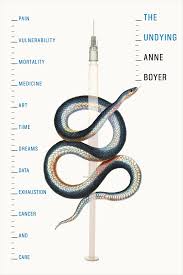Megan Marz at The Baffler:
 The book is “an autobiographical account of what it is like to have a body in a specific time and place,” to borrow Boyer’s description of Hieroi Logoi (Sacred Tales) by the second-century Greek orator Aelius Aristides, one of many texts and artworks about illness and pain that Boyer references, quotes from, and argues with, placing her writing in their lineage. The prologue to The Undying explains what makes her specific time and place—and the literary forms they demand—different from those of breast cancer patients who came before. When Fanny Burney described her pre-anesthesia mastectomy in a 1812 letter to her sister, she was articulating a rare experience at the great personal cost of reliving the nearly unbearable. When Audre Lorde’s Cancer Journals were published in 1980, her first-person account of cancer rippled through a surrounding quiet. Until more recently, people didn’t often discuss their diagnoses in public. Susan Sontag and Rachel Carson each had breast cancer, yet wrote about cancer without addressing their own.
The book is “an autobiographical account of what it is like to have a body in a specific time and place,” to borrow Boyer’s description of Hieroi Logoi (Sacred Tales) by the second-century Greek orator Aelius Aristides, one of many texts and artworks about illness and pain that Boyer references, quotes from, and argues with, placing her writing in their lineage. The prologue to The Undying explains what makes her specific time and place—and the literary forms they demand—different from those of breast cancer patients who came before. When Fanny Burney described her pre-anesthesia mastectomy in a 1812 letter to her sister, she was articulating a rare experience at the great personal cost of reliving the nearly unbearable. When Audre Lorde’s Cancer Journals were published in 1980, her first-person account of cancer rippled through a surrounding quiet. Until more recently, people didn’t often discuss their diagnoses in public. Susan Sontag and Rachel Carson each had breast cancer, yet wrote about cancer without addressing their own.
Over time, the narrative of breast cancer has evolved. “The silence around breast cancer that Lorde once wrote into is now the din of breast cancer’s extraordinary production of language,” Boyer writes.
more here.
